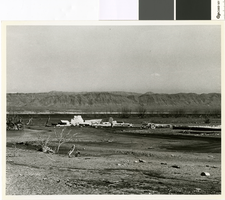Search the Special Collections and Archives Portal
Search Results
Celese Rayford oral history interview
Identifier
Abstract
Oral history interview with Celese Rayford conducted by Phillip Walley on November 14, 2015 for the African Americans in Las Vegas: a Collaborative Oral History Project. In this interview, Rayford discusses her career as an educator in Las Vegas, Nevada. She begins by describing her upbringing in Las Vegas, the Westside community of Las Vegas, and attending Spellman College in Atlanta, Georgia. Rayford then discusses her involvement with Top Teens of America and how that program helps to prepare young girls for college. She continues, talking about the effectiveness of disciplinary action against students, her experiences from her first year of teaching, and headstart programs for students who live in poverty.
Archival Collection
Rick Peppers oral history interview
Identifier
Abstract
Oral history interview with Rick Peppers conducted by Claytee D. White on July 06, 2016 for the Boyer Early Las Vegas Oral History Project. In the interview, Peppers describes his childhood in Exira, Iowa and moving to Blue Diamond, Nevada in 1962. He explains working in various positions at the Blue Diamond Mine to ensure employment stability. Peppers shares stories about how the mine company's ownership of Blue Diamond affected the town. After transitioning into security jobs, he explains working through the Teamsters Union at the Aladdin Hotel and Casino, and then working forty-six years at Caesars Palace Hotel and Casino in Las Vegas, Nevada.
Archival Collection
Bob Fisher oral history interview
Identifier
Abstract
Oral history interview with Robert Fisher conducted by Barbara Tabach on January 08, 2015 for the Southern Nevada Jewish Heritage Project. In this interview, Fisher discusses his childhood in Minnesota, and the large role Judaism played in his upbringing. He speaks at length about his involvement with United Synagogue of Conservative Judaism over the years, including as regional director of the United Synagogue Youth Far West Region, which took him from Minnesota to California. He talks about his time in Los Angeles, California, and later, about his life in Las Vegas, Nevada, including his broadcasting career as well as involvement with Midbar Kodesh Temple.
Archival Collection
Joseph Digles oral history interview
Identifier
Abstract
Oral history interview with Joseph Digles conducted by Kathleen Wilcox on March 01, 1980 for the Ralph Roske Oral History Project on Early Las Vegas. Digles discusses his career as an editor of the
Archival Collection
Reva Giles oral history interview
Identifier
Abstract
Oral history interview with Reva Giles conducted by Claytee D. White on July 17, 2006 for the UNLV @ 50 Oral History Project. Giles discusses moving to Las Vegas, Nevada in 1958, then recalls living on Decatur and the military housing at Nellis Air Force Base. She then discusses moving from Las Vegas to Okinawa, Japan for four years with her husband, and upon his retirement from the military, moving back to Las Vegas in 1964. She also discusses working in various offices at the University of Nevada Las Vegas (UNLV), retiring and volunteering as an office aide to the UNLV athletic director.
Archival Collection
Julio Lucchesi oral history interview
Identifier
Abstract
Oral history interview with Julio Lucchesi conducted by an unidentified interviewer on December 21, 2001. Luchessi discusses his decision to become an architect, as well as his desire to become an aviator. He reads extensively from his autobiography in progess, of his education, his time in the Army Air Corps during World War II, and his decision to move to Nevada. He also talks about the formation and development of the American Institute of Architecture (AIA) in Nevada, his efforts to change the exam process for new architects in the state, and the eleven-year struggle to establish a school of architecture at the University of Nevada, Las Vegas (UNLV) in Las Vegas, Nevada.
Archival Collection
Gloria Dixon oral history interview
Identifier
Abstract
Oral history interview with Gloria Dixon conducted by Claytee D. White on May 2, 2022 for the African Americans in Las Vegas: A Collaborative Oral History Project. In this interview, Dixon recalls her childhood growing up in Las Vegas, Nevada. Dixon attended St. Christopher and Bishop Gorman High School, and recalls her parents' involvement in the New Jerusalem Church. Dixon discusses writing grants to help with community education programs, and using her experience as a hospice nurse for the last thirty years to help communicate information about public health crises. Throughout the interview, Dixon shares information about the businesses in the Las Vegas Black community on Jackson Street.
Archival Collection

Transcript of interview with Lyn Robinson by Barbara Tabach, September 18, 2014
Date
Archival Collection
Description
One day in 2012, UNLV student Lyn Robinson spied a posting on the bulletin board for a photographer for the Sperling Kronberg Mack Holocaust Resource Center. She was an art major with a concentration on photography. She was also had a deep appreciation of the horror of the Holocaust and what the survivors she would take photos of had endured. Thus began a two year project, during which she took photos of over sixty survivors. Her images are preserved at UNLV Special Collections & Archives. Prints are displayed at the Sperling Kronberg Mack Holocaust Resource Center. On September 18, 2014, Lyn shared her work for this oral history recording. She is a native of Florida, daughter of a horticulturist father and pianist mother.
Text
Don Ashbaugh Papers on Nevada Ghost Towns
Identifier
Abstract
The Don Ashbaugh Papers (1950-1960) document Las Vegas history, Nevada history, and ghost towns. The collection is comprised of the working manuscript of Don Ashbaugh's book, Nevada's Turbulent Yesterday: A Study in Ghost Towns. The collection also contains typescript drafts, newspaper clippings, and a geographical index of Nevada ghost towns.
Archival Collection

Photograph looking southeast through the remains of the post office in St. Thomas, Nevada, 1948
Date
Archival Collection
Description
The remains of the St. Thomas post office and Harry Gentry's store with Lake Mead in the background
Transcribed Notes: Bureau of Reclamation typed notes appended to back of photo: Boulder Canyon Project--Nevada--Region 3 St. Thomas, Nevada, was founded by the Mormons in 1855. In its heyday there were about 800 residents in the village. The "Main Street" was a part of the old Arrowhead Trail, which led from Salt Lake City, Utah to Los Angeles, California. In June 1938 the town was abandoned by its residents, which at that time were few in number because of the rising waters of Lake Mead that submerged the townsite. In 1945, after having been flooded for 7 years, receding waters of Lake Mead revealed St. Thomas much as it has appeared in former years. This photo was taken looking toward Mormon Mesa. The receding waters of the lake can be seen in the center of the photo.
Image
